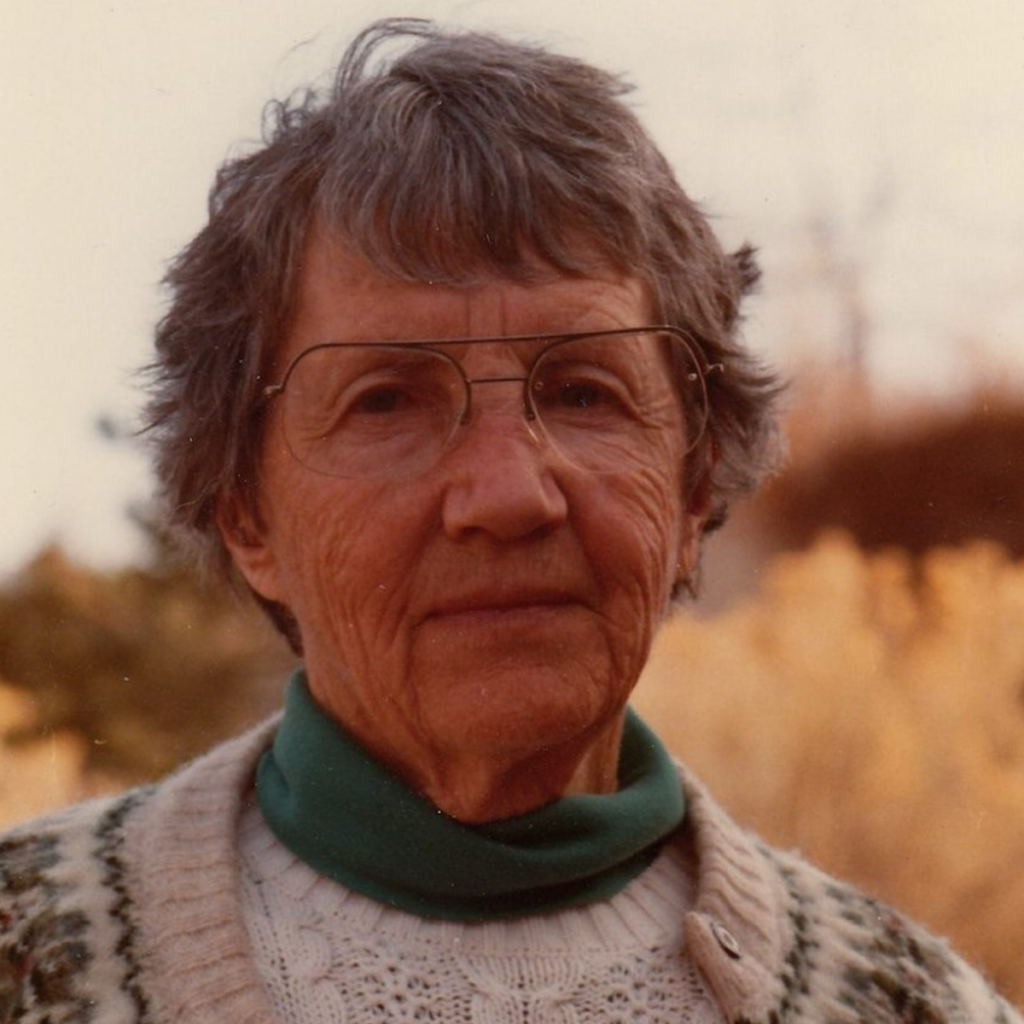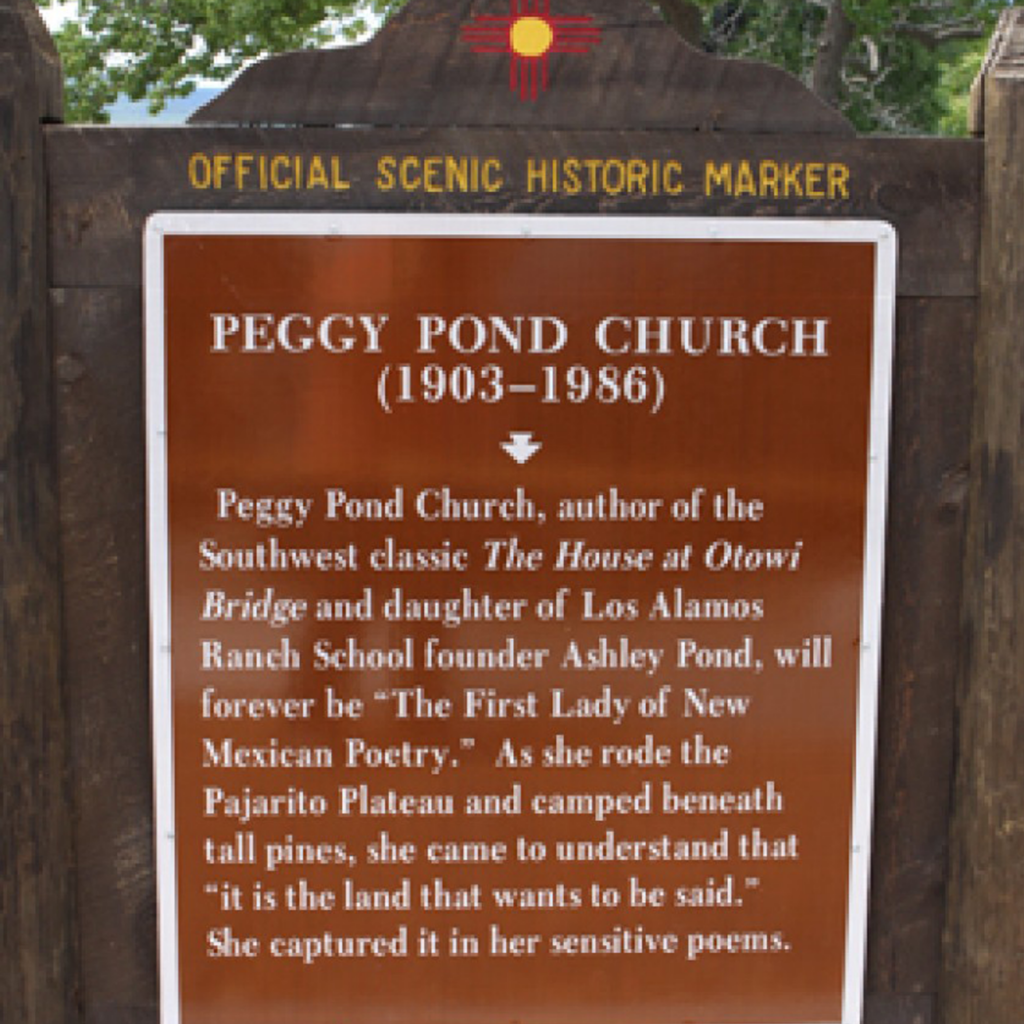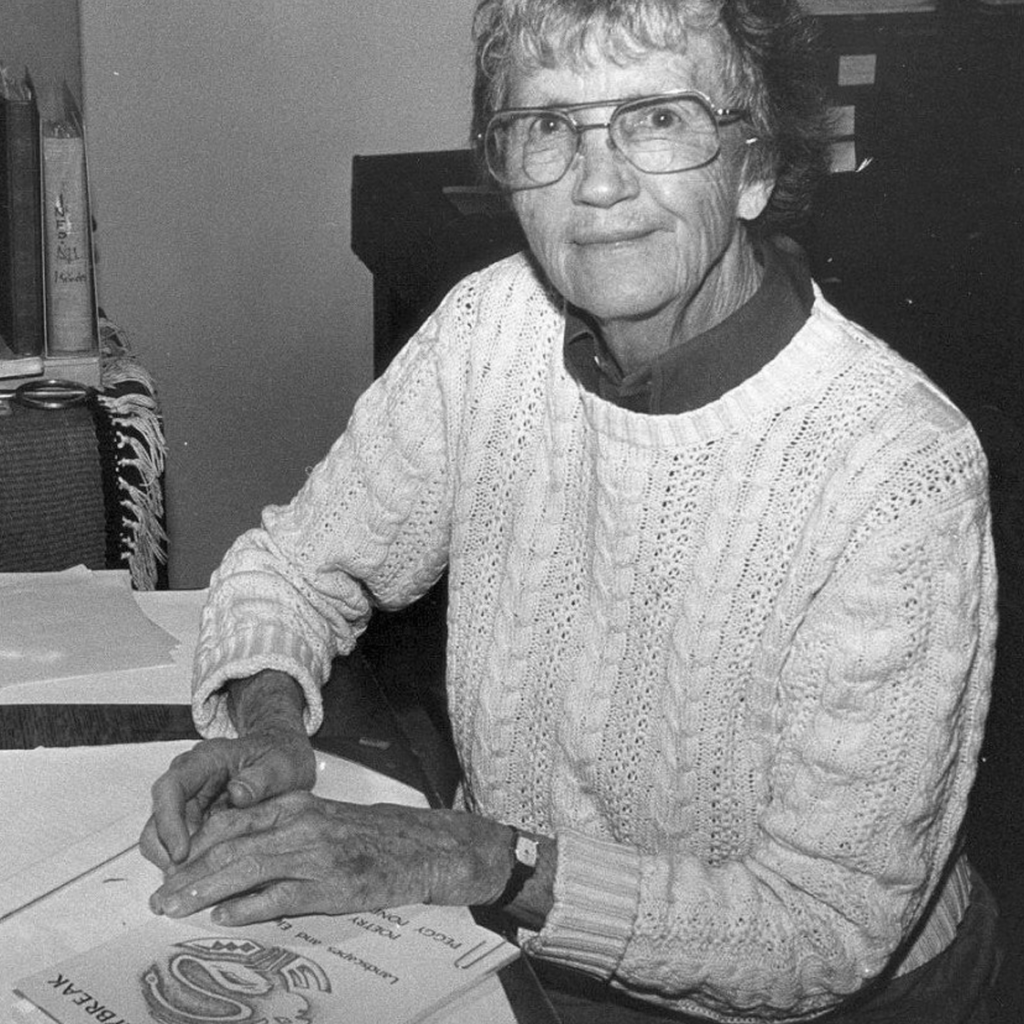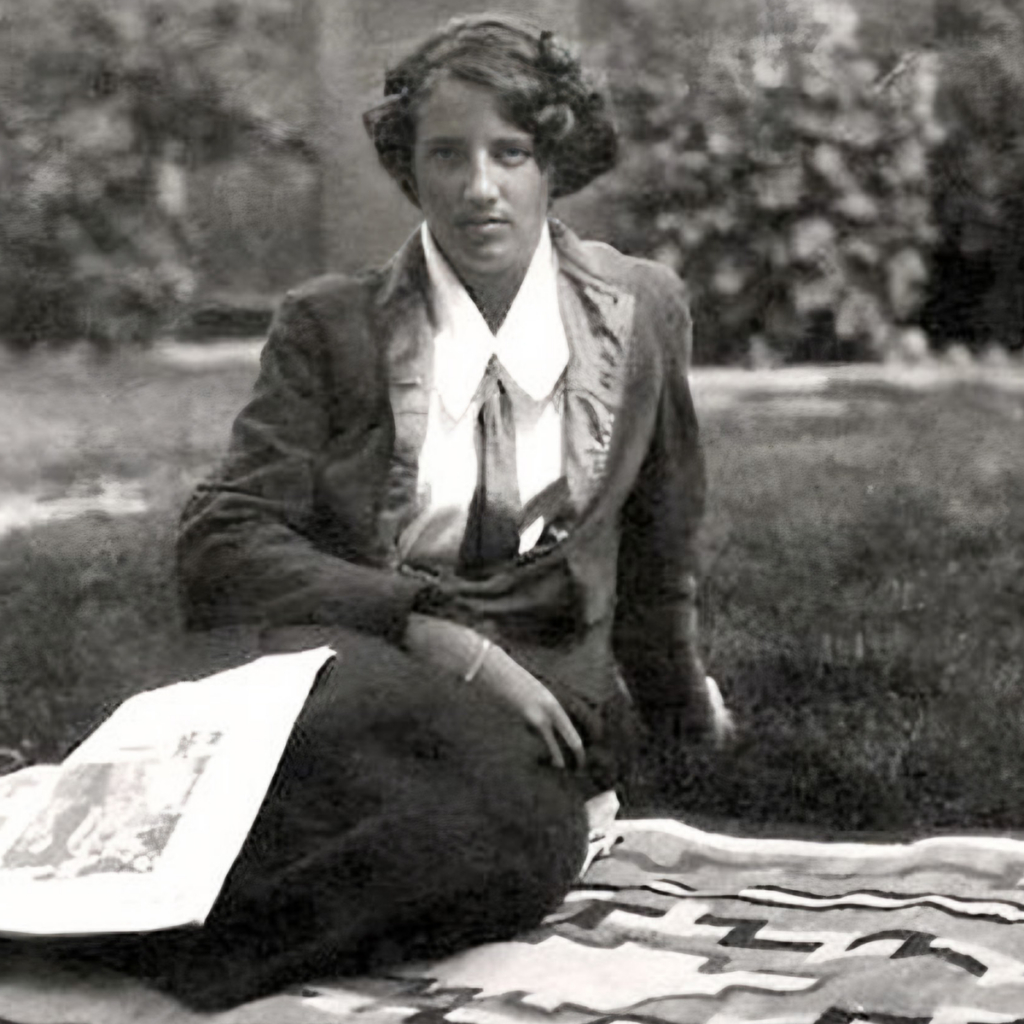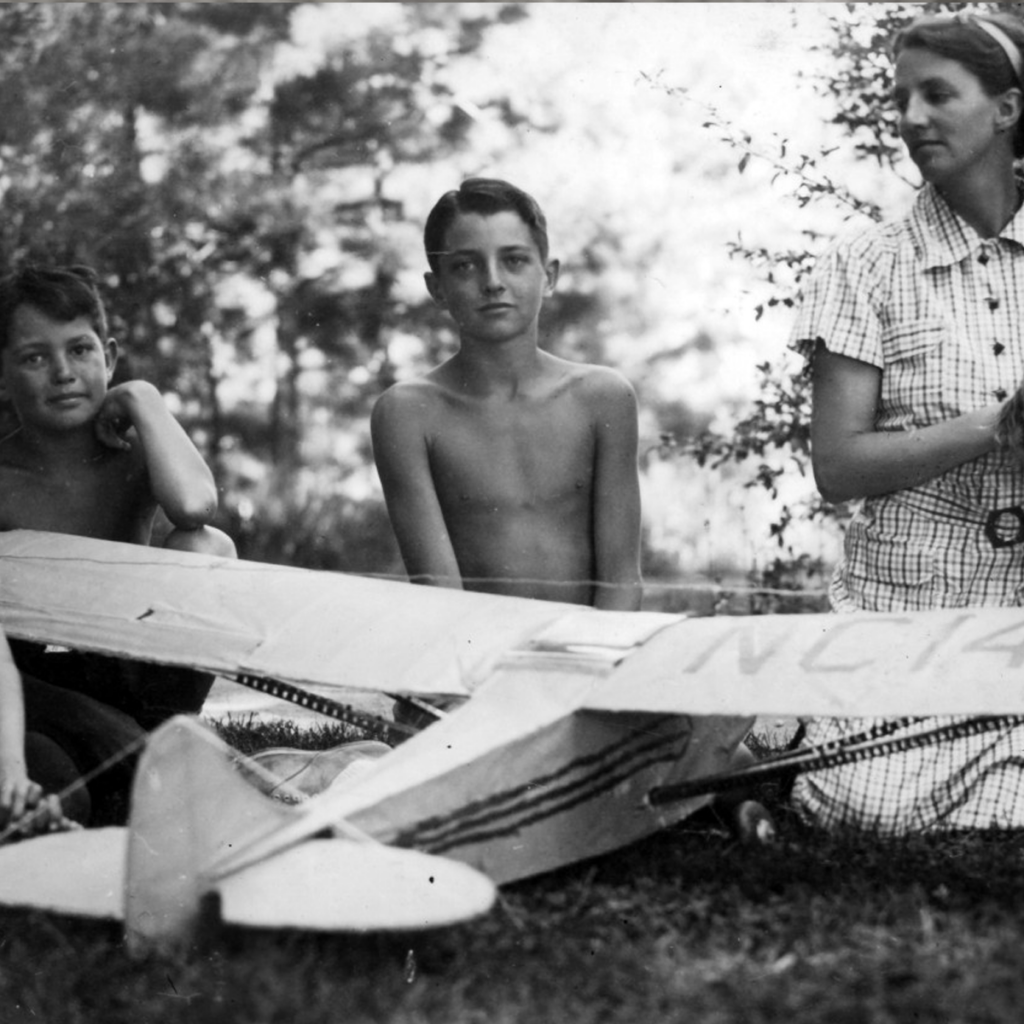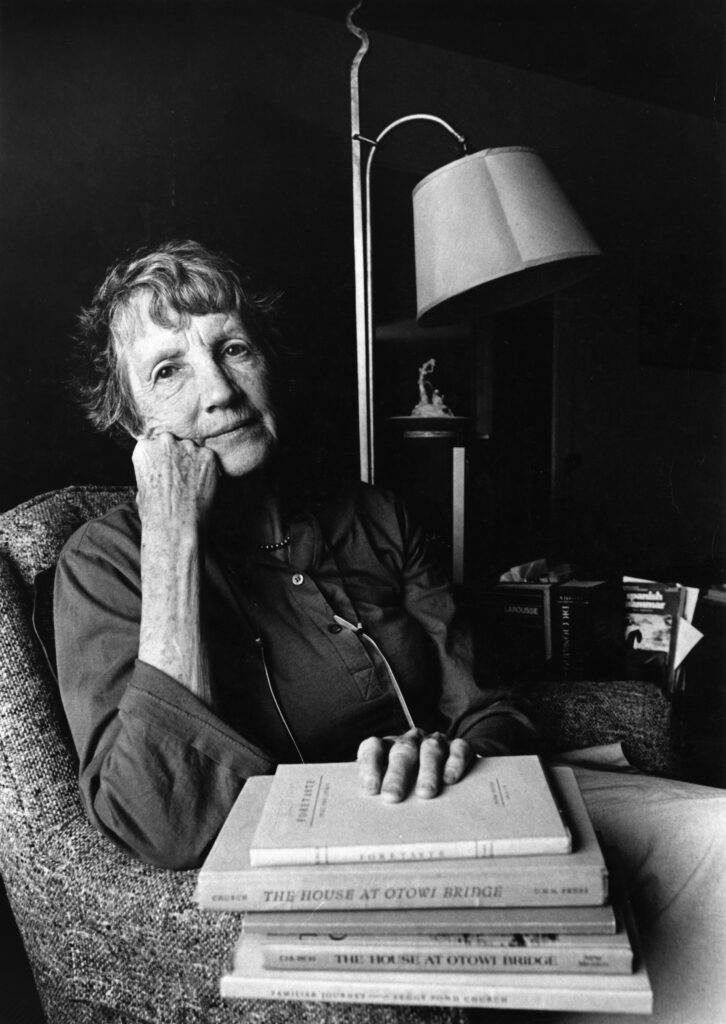Peggy Pond Church.
Peggy Pond Church
1903 - 1986
Los Alamos County
A noted author for her poetry, novels, and memoirs, she captured the unique beauty of New Mexico’s land and people, leaving a legacy in her literature that both described and shaped the culture of the state. Shortly before her death in 1986, she was named a Living Treasure of Santa Fe.
Drawing from a childhood spent freely in the Jemez Mountains exploring Pajarito Canyon on horseback and playing in cliff dwellings with her siblings, Peggy Pond Church spent her life writing about the beauty of New Mexico, in poetry, novels, and memoirs. Widely recognized for her unique voice and contributions to New Mexico literature and culture, she is “the First Lady of New Mexican Poetry.”
Peggy Pond was born in the Territory of New Mexico in 1903 near Watrous, at a place known as Valmora. Her father was Ashley Pond, Jr., the son of a wealthy Detroit attorney. He had been in Teddy Roosevelt’s Rough Riders before falling ill with typhoid fever and coming to New Mexico to recuperate. Peggy’s mother, Hazel Hallett Pond, was the granddaughter of a former Arkansas governor who had retired to the area of Mora County to ranch.
While her roots were in northeastern New Mexico, her destiny awaited on the Pajarito Plateau in the Jemez Mountains. In 1914, her father and four other Detroit businessmen opened the Pajarito Club, designed as an elite hunting and fishing retreat. The venture failed, but her father remained on the plateau and founded a more successful operation in 1917—the Los Alamos Ranch School for boys. Angry with her father for designing his school for boys only, the young Peggy attended boarding schools in California and Connecticut. She loved horses and the outdoors and would have gladly traded places with her younger brother who was a student at the ranch school.
Along with a younger sister, she and her siblings enjoyed a childhood of unique freedom. They were allowed to ride their horses through Pajarito Canyon, play in the cliff dwellings, build fires to roast apples, and explore ruins. The sense of independence coupled with the isolation of the plateau nurtured Peggy’s keen sense of observation. At an early age she felt the need to express her thoughts in poetry, writing her first poem at age thirteen.
By the time Peggy Pond entered Smith College, she had won awards for her poetry and was achieving recognition. Although she loved college life, she was homesick for New Mexico, and jumped at the chance to marry a young master at the Los Alamos Ranch School and return to the Pajarito Plateau. She married Fermor “Ferm” Spencer Church in 1924, and they raised three sons at the school. During this time, she published two volumes of poetry and an award-winning children’s book, The Burro of Angelitos. She was a respected member of the Santa Fe writers’ colony, despite living 35 miles away. Her first two books, Foretaste and Familiar Journey, were among the seventeen Santa Fe Writers’ Editions, now highly collectible.
Her success and happiness on the plateau were abruptly uprooted in 1942 when the government took over the school for the top secret Manhattan Project. Distraught and somewhat bitter, the family moved to Taos, and in 1946 Peggy Pond Church published Ultimatum for Man, a volume of poems considered by many to be her best and strongest work. The poems arose from her pain over losing her beloved home and from her pacifist beliefs that collided with the development of the atomic bomb.
In the 1950s, her husband found work as an engineer in California, and she entered into Jungian analysis at Berkeley. At the same time, she completed what would become her most famous work and a southwestern classic, The House at Otowi Bridge. The work was a dual memoir with her friend Edith Warner, who had been the connection between the old world of the Pueblos and the ranch school and the new world of the scientists. It was a book of healing for the many who had been displaced and felt loss because of the war.
In 1960, the Churches returned to Santa Fe, where they would live out their lives. Their three sons became scientists and engineers and worked at Sandia Laboratories. Ferm Church poured his energies into the Citizens for Clean Air and Water, while Peggy Church continued to write of the beauty of the land and her sensitive observations of life. She produced four more volumes of poetry and wrote a biographical work about Mary Austin, a grand dame of the early Santa Fe literary scene.
In 1984, Peggy Pond Church was honored with the Governor’s Award for Excellence and Achievement in the Arts in the category of literature. Shortly before her death in 1986, she was named a Living Treasure of Santa Fe. She was a source of pride for her native state and received well-deserved recognition for interpreting the beauty of New Mexico while contributing to the state’s cultural heritage. One of her most famous quotes captures her unassuming way and the basic belief she expressed through her writing: “It’s the land that wants to be said.”
Additional Information:
Published Works by Peggy Pond Church
Poetry
Church, Peggy Pond. Foretaste (Rydal Press, Santa Fe Writers’ Editions, 1933)
Church, Peggy Pond. Familiar Journey. Rydal Press, Santa Fe Writers’ Editions, 1936.
Church, Peggy Pond. Ultimatum for Man. James Ladd Delkin, Stanford University, 1946.
Church, Peggy Pond. New and Selected Poems. Boise, ID:Ahsahta Press, 1976. *
Church, Peggy Pond. The Ripened Fields: Fifteen Sonnets of a Marriage. Santa Fe:The Lightning Tree, 1978.
Church, Peggy Pond. The Lament at Tsankawi Mesa. Santa Fe:Thistle Press, 1980.
Church, Peggy Pond. A Rustle of Angels. Denver:Peartree Press, 1981.
Church, Peggy Pond. Birds of Daybreak. (Santa Fe:William Gannon, 1985.
Church, Peggy Pond. This Dancing Ground of Sky. Santa Fe:Red Crane Books, 1993.*
Church, Peggy Pond. Accidental Magic. Albuquerque:Wildflower Press, 2004. *
Memoirs
Church, Peggy Pond. The House at Otowi Bridge. University of New Mexico Press, 1960. *
Church, Peggy Pond. “On Building a Bridge” New America, UNM, Spring 1979.
Church, Fermor S. and Peggy Pond Church. When Los Alamos was a Ranch School. Los Alamos Historical Society, 1998. *
Children’s Book
Church, Peggy Pond. The Burro of Angelitos. London:Suttonhouse, Ltd., 1936. (Award Winner of the Julia Ellsworth Ford Foundation for Children’s Literature, 1937)
Biography
Church, Peggy Pond. Wind’s Trail: The Early Life of Mary Austin. Edited by Shelley Armitage, Santa Fe:Museum of New Mexico Press, 1990.
* Still in Print
Sources:
Snyder, Sharon. At Home on the Slopes of Mountains. (working title) upcoming biography of Peggy Pond Church.
Church, Peggy Pond. The House at Otowi Bridge. UNM Press, 1960.
Directions:
Peggy Pond Church
Los Alamos County
Activist | Artist |
Statehood (1912 - present) | Territorial Period (1848 - 1912) |
Central



